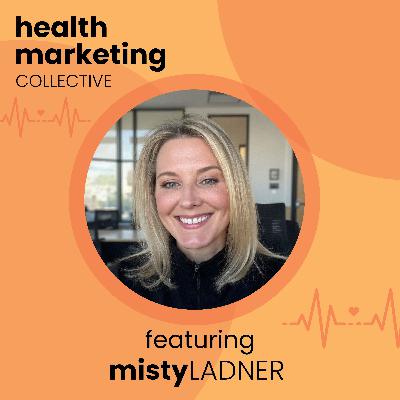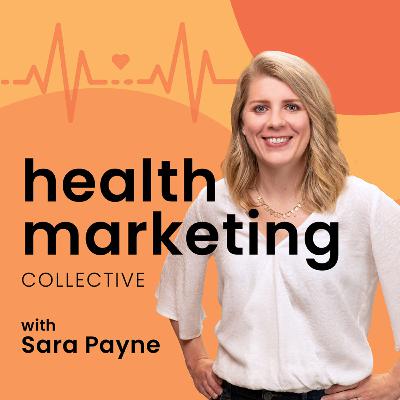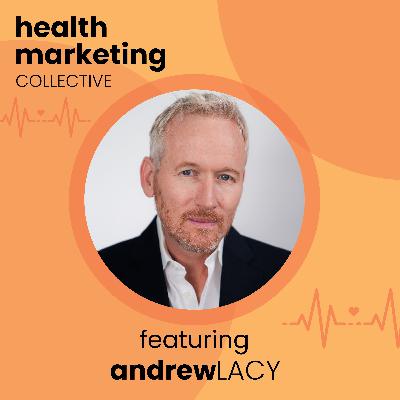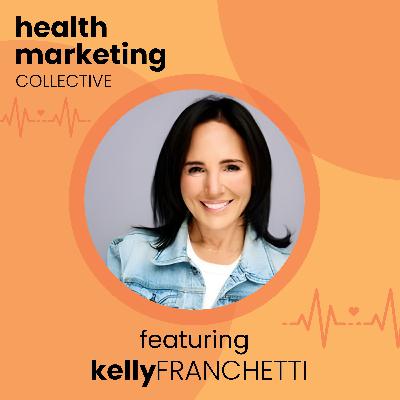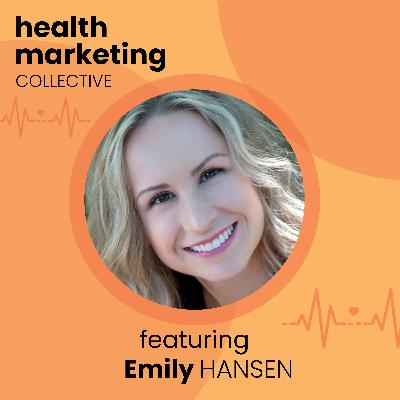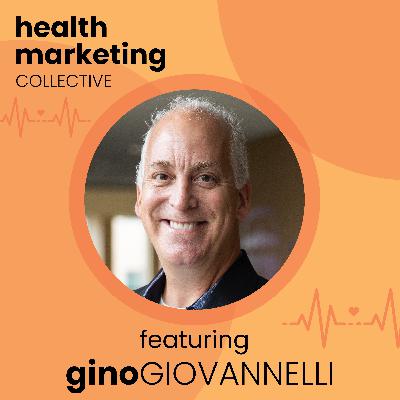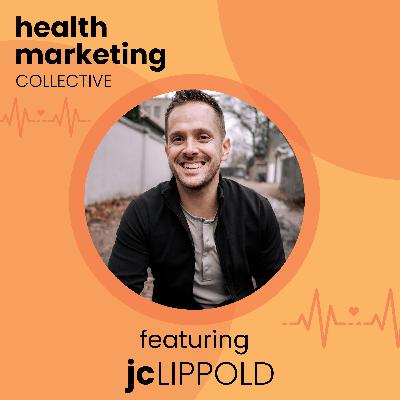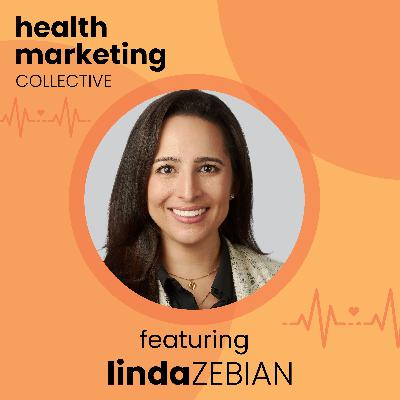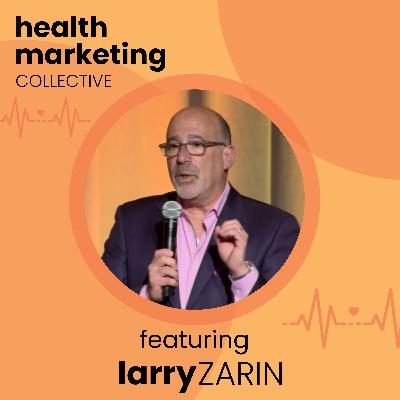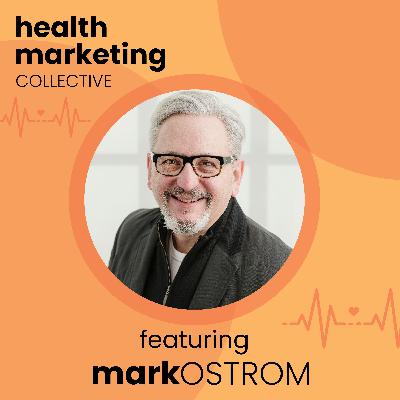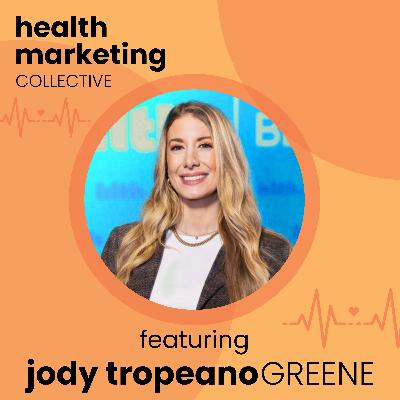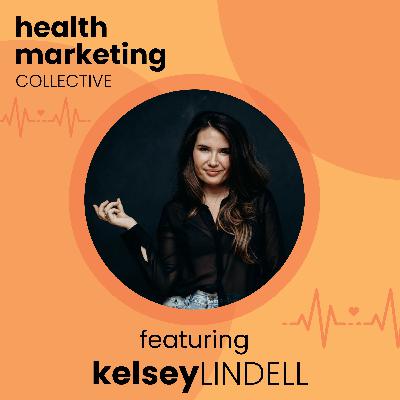Discover Health Marketing Collective
Health Marketing Collective

Health Marketing Collective
Author: Inprela Communications
Subscribed: 1Played: 49Subscribe
Share
© Copyright 2025 Inprela Communications
Description
*2024 Signal Award Winner*
Welcome to the Health Marketing Collective, where we’re tackling issues at the intersection of health marketing leadership and brand-building excellence. By bringing together top minds in marketing, we’re creating a space for candid conversations that have the power to shape the future of healthcare.
This is a place where healthcare marketing leaders share success stories and inspire others to leverage the power of storytelling to drive positive change and propel their businesses forward. We believe storytelling can change the status quo–and we’ve seen it happen.
Sara Payne, the president and chief healthcare strategist at Inprela Communications, hosts the show, bringing more than 20 years of experience navigating the complex healthcare landscape. A trusted partner to many executives and chief marketing officers, she and her team have helped companies build campaigns that break through the noise, create movements, and establish brands as leading voices in the industry.
But we’re just getting started.
The Health Marketing Collective aims to broaden the spotlight, highlighting great people who are leading life-changing, brand-building campaigns. We’re handing over the mic and inviting thought leaders to share their own stories of removing hurdles to fulfill the health industry’s true potential.
Tune in every other Wednesday for new episodes featuring prolific leaders and marketing experts, engaging in thought-provoking conversations (and a few laughs) about:
Brand-building in the healthcare space
How to become a leading voice in the industry
Methods for changing consumer behavior
Public relations, content creation, social media, and marketing for health-focused companies
How to drive your company forward through issues-based storytelling
Welcome to the Health Marketing Collective, where we’re tackling issues at the intersection of health marketing leadership and brand-building excellence. By bringing together top minds in marketing, we’re creating a space for candid conversations that have the power to shape the future of healthcare.
This is a place where healthcare marketing leaders share success stories and inspire others to leverage the power of storytelling to drive positive change and propel their businesses forward. We believe storytelling can change the status quo–and we’ve seen it happen.
Sara Payne, the president and chief healthcare strategist at Inprela Communications, hosts the show, bringing more than 20 years of experience navigating the complex healthcare landscape. A trusted partner to many executives and chief marketing officers, she and her team have helped companies build campaigns that break through the noise, create movements, and establish brands as leading voices in the industry.
But we’re just getting started.
The Health Marketing Collective aims to broaden the spotlight, highlighting great people who are leading life-changing, brand-building campaigns. We’re handing over the mic and inviting thought leaders to share their own stories of removing hurdles to fulfill the health industry’s true potential.
Tune in every other Wednesday for new episodes featuring prolific leaders and marketing experts, engaging in thought-provoking conversations (and a few laughs) about:
Brand-building in the healthcare space
How to become a leading voice in the industry
Methods for changing consumer behavior
Public relations, content creation, social media, and marketing for health-focused companies
How to drive your company forward through issues-based storytelling
49 Episodes
Reverse
Welcome to the Health Marketing Collective, where strong leadership meets marketing excellence.On today’s episode, Sara Payne sits down with Misty Ladner, Senior Vice President of Consumer Marketing at Wondr Health, to explore the intersection of science, storytelling, and empathy in healthcare marketing. Together, they unpack what it truly takes to motivate people to engage with their health, translating awareness into lasting action. Misty brings decades of experience in designing digital programs that tackle obesity and chronic disease, always with a focus on building trust, changing behavior, and humanizing healthcare.Our conversation covers everything from the fundamental differences between tech marketing and healthcare marketing, to balancing creativity and compliance, behavioral science-backed approaches to consumer engagement, and the evolving role of AI and data personalization in building meaningful and effective marketing strategies. We dive into real stories of impact—like Teddy’s transformation—and highlight how marketing leaders can anchor strategy in compassion and measurable consumer outcomes rather than just transactional metrics.Thank you for being part of the Health Marketing Collective, where strong leadership meets marketing excellence. The future of healthcare depends on it.Key Takeaways:Trust Is the Cornerstone of Healthcare MarketingMisty breaks down the fundamental difference between tech and healthcare marketing: while tech often leans on delight and convenience to drive adoption, healthcare is inherently personal and emotional. Building trust is non-negotiable—it’s the foundation that enables patients to take action, especially when dealing with vulnerable topics like weight loss and chronic disease. Wondr Health’s approach emphasizes empathy, thought leadership, and the creation of personal mirrors: “We have helped people like you—so we can help you.”Personalization Drives Long-Term Consumer EngagementRather than treating marketing as a transaction, Misty and her team root engagement strategies in behavioral science and behavioral economics. By understanding each individual’s intrinsic and extrinsic motivators—the “my why”—Wondr Health personalizes not just their product, but every touchpoint, reward, and message a consumer encounters. Moving toward one-to-one personalization, operationalized across the entire lifecycle, is key to helping people stick to their health goals and achieve lasting change.Data and AI: The Path to Scalable CustomizationSuccess in personalized engagement relies on scalable technology. Misty shares how Wondr Health is investing in AI-driven platforms and unified datasets to power true one-to-one communication—from email to SMS to live coaching. AI allows marketers to move beyond broad population segments to individualized experiences, orchestrating communication across channels and continuously optimizing based on real-world data.Consumer Outcomes Must Anchor Metrics and StrategyHealthcare marketers often fall into the trap of treating engagement as a set of transactional metrics—open rates, clicks, retention. Misty urges leaders to keep consumer health outcomes at the center: sleep, energy, joy, and confidence are as important as clinical results. Wondr Health’s culture and business reviews start with participant stories and testimonials, tying business objectives directly to consumer impact and clinical outcomes.Humanizing Strategy: Keep the Individual Front and CenterAbove all, Misty advocates for approaching every campaign as if you’re speaking to a loved one—your mother, aunt, sister, or child. Marketers must remember that behind every data point is a person with a story and a motivation. Relevance, empathy, and connection build trust and drive the real,...
Welcome to the Health Marketing Collective, where strong leadership meets marketing excellence.On today’s episode, host Sara Payne sits down with Kala Weeks, Vice President of Marketing and Communications for Reperio Health, for a compelling conversation at Health 2025. Reperio Health is transforming preventive care with at-home screening kits and instant results—delivering accessibility, convenience, and speed straight to consumers’ doorsteps. Together, they explore how bold, human-centered approaches in health marketing are breaking through industry noise and shaping the future of care.Kala Weeks shares her philosophy that all buyers are humans first—offering unique insights from her psychology background on why healthcare marketing so often misses the personal touch and how trend-driven campaigns can connect with real people, even in a B2B environment. They delve into Reperio's innovative “trend jacking” strategies, the critical role of leadership support and team nimbleness, the delicate balance between clinical credibility and creative relevance, and the importance of listening deeply to audiences. Plus, learn why Kala Weeks believes we’re at the cusp of a preventive care revolution, and how Reperio is helping consumers overcome fear to embrace their health.Thank you for being part of the Health Marketing Collective, where strong leadership meets marketing excellence. The future of healthcare depends on it.Key Takeaways:Human-First Marketing in Healthcare: Kala Weeks underscores the importance of treating buyers as multidimensional humans, not just personas or ICPs. By infusing a psychology-based understanding of what motivates real people—both in their professional and personal lives—Reperio Health creates campaigns that are relatable and resonant, helping the industry move beyond flat, transactional interactions.Trend Jacking for Disproportionate Attention: Reperio Health leverages pop culture moments to make preventive care feel accessible and fun, a strategy Kala Weeks calls “trend jacking.” By connecting universal healthcare needs to widely recognized events (such as clever plays on the American Eagle jeans campaign or Taylor Swift’s candid discussions about family health), marketing efforts gain significant traction and relevance, driving brand recall and engagement even in a competitive B2B landscape. Agility Backed by Leadership and Technology: Nimbleness—both in team structure and campaign approval processes—is essential for capturing fleeting cultural moments. Kala Weeks shares how actionable leadership buy-in and creative liberty empower Reperio's small team to move fast. Technology plays a vital supporting role, with custom AI tools scanning news and pop culture daily to identify opportunities, highlighting the critical intersection of innovation and strategic operations.Balancing Creativity and Clinical Credibility: Staying fresh and relevant doesn’t mean sacrificing trust. Reperio Health maintains clinical credibility by anchoring its messaging in data, published case studies, and well-defined content pillars. This approach allows them to be playful and bold with campaigns while consistently reinforcing medical expertise and reliability—building brand authority among clinical and consumer audiences alike.Listening as a Path to Trust and Adoption: Shifting consumer mindsets from fear of preventive care to embracing proactive health starts with active listening. Kala Weeks emphasizes the necessity of audience research and adapting voice and tone to build authenticity and trust. By prioritizing genuine dialogue over broadcasting, Reperio can address barriers, foster engagement, and truly put the healthcare consumer at the center—essential for thriving in today’s preventive care revolution.Join us at the Health Marketing...
Welcome to the Health Marketing Collective, where strong leadership meets marketing excellence.
In today’s episode, our host Sara Payne is joined by Andrew Lacy, CEO of Prenuvo, recorded live on the floor of HLTH 2025. Together, they dive into the evolving landscape of preventive healthcare, examining the bold moves required to shift from reactive late-stage disease management to proactive early detection and holistic diagnostics.
Andrew brings his experience as an innovator in healthcare, spearheading Prenuvo’s mission to redefine the annual physical through advanced whole-body imaging and blood biomarkers. Their approach opens the door to detecting life-threatening diseases earlier and helping individuals understand the real impact their lifestyle has on long-term health outcomes.
The conversation explores why the traditional health system is lagging in diagnostics, the uncomfortable truths that must be confronted for meaningful change, and how both messaging and clinic experience play a critical role in overcoming patients' fear and nurturing gratitude after preventive screening. Sara and Andrew also touch on the systemic and economic challenges of proving ROI for preventive innovations, especially with employers and payers, and how data-driven evidence and strategic partnerships can unlock wider adoption.
Thank you for being part of the Health Marketing Collective, where strong leadership meets marketing excellence. The future of healthcare depends on it.
Key Takeaways:
A New Model for the Annual Physical: Andrew Lacy describes Prenuvo as the “annual physical of the future,” integrating whole-body imaging and blood biomarkers to proactively identify disease. By offering a more comprehensive view than traditional checkups, Prenuvo aims to close the gaps left by current approaches which often produce false negatives and leave individuals in the dark about their health status.
Uncomfortable Truths Behind Early Detection: The episode highlights a critical mindset shift required in healthcare: current cancer screenings cover only about 14% of diagnosed cancers, leaving vast blind spots across organs like the liver, kidneys, and brain—areas rarely screened. Andrew emphasizes that true reform lies in challenging incremental fixes and pushing for large-scale preventive health solutions, even as system inertia resists radical change.
Mindset, Messaging & Patient Experience: Fear and anxiety are common reactions to the idea of deep health screening, not just for patients but also physicians. Andrew discusses how Prenuvo addresses this by offering warm, inviting clinic environments and reframing preventive health as a form of empowerment rather than dread. Breaking down these psychological barriers through thoughtful marketing and messaging is essential for shifting public and professional attitudes.
Driving Adoption Through Education & Evidence: Change doesn’t happen overnight. Prenuvo’s strategy involves educating physicians—often skeptics themselves—by turning them into advocates after experiencing screenings personally or through their patients. The company is investing in prospective clinical trials to gather the long-term data necessary for convincing payers, employers, and insurance providers to support and cover preventive diagnostics.
Navigating Economic Challenges for Preventive Health: One of the episode’s key marketing challenges is proving the ROI for preventive interventions in a system where patients often change jobs (and insurance plans). Andrew shares how partnering with blue-collar employers, who see long-term employee loyalty and higher occupational risks, provides an ideal proving ground for demonstrating impact. This targeted approach lays the groundwork for broader adoption, beginning with high-risk populations and expanding coverage...
Welcome to the Health Marketing Collective, where strong leadership meets marketing excellence.
On today’s episode, we’re thrilled to welcome Kelly Franchetti, CEO of The Patient View, as she joins host Sara Payne for a candid discussion on what it truly means to put patients at the heart of health marketing. As an insights leader, nurse, and rare disease mom, Kelly fuses her unique personal and professional experiences to advocate for authentic patient engagement, offering actionable strategies for brands to move beyond lip service and embrace genuine patient-centricity.
Kelly brings a compelling perspective on the patient journey, informed by her own family’s experiences navigating rare diseases and clinical trials. She shares how her advocacy work led her to challenge the healthcare and pharma status quo, calling for substantive involvement of patients in every aspect of study design, marketing, and support program development.
Throughout the conversation, Sara and Kelly explore why “patient-centric” risks becoming just another buzzword, how to avoid costly missteps by listening to patient insights, and the organizational challenges that often stall efforts to turn data into change. They discuss real-life examples of brands pivoting strategies in response to patient feedback, and highlight the importance of enterprise-wide buy-in, frequent iteration, and empathy as foundational principles in modern health marketing.
Key Takeaways:
Patient-Centricity Must Be Actionable, Not Just Aspirational:
Kelly underscores that real patient-centricity requires actively seeking out patient perspectives through research and acting on what is learned. It’s not about relying solely on AI or superficial data; it’s about integrating genuine patient voices, frequently revisiting those insights, and ensuring they shape every aspect of marketing and brand strategy.
Enterprise Buy-In Drives Change, While Siloes Stall Progress:
One of the main reasons patient insights aren’t implemented is the lack of enterprise-level buy-in. Kelly points out that meaningful change rarely happens in fragmented organizations. Successful brands foster cross-functional alignment and maintain internal champions who advocate for patients throughout all stages of research, development, and commercialization.
Early and Iterative Engagement Avoids Costly Missteps:
Kelly shares powerful examples of campaigns and trial materials that dramatically changed direction thanks to patient feedback. For instance, using “the wrong shade of pink” for triple negative breast cancer materials nearly became an expensive mistake. Bringing patient input in early—and returning for further feedback during iteration—saves resources and enhances resonance.
Empathy and Authenticity Build Trust:
Marketers often underestimate how small gestures—like mentioning that support materials were created with real patients and caregivers—can foster trust. Empathy is the foundation of truly patient-centric marketing. It's not enough to assume clinical expertise translates into understanding; language and context must be shaped by authentic patient experience.
Patient Insights Can Be Quick, Cost-Effective, and Highly Influential:
Kelly dispels myths that rigorous patient research is always expensive or slow. Reviewing existing data, leveraging small rapid studies, and continually refreshing patient advisory boards are accessible ways to keep messaging and services aligned with evolving patient needs. The key is to act, even if incrementally, and recognize that integrating the patient perspective is a journey—not a one-time project.
Don’t forget to subscribe wherever you get your podcasts. Thank you for tuning in to the Health Marketing Collective, where strong leadership...
Welcome to the Health Marketing Collective, where strong leadership meets marketing excellence.
On today’s episode, Sara Payne sits down with Emily Hansen, Senior Director of the Resensation program at Axogen, to discuss how healthcare brands can leverage thought leadership to reshape public perceptions, influence behavior change, and ultimately become architects of a health revolution.
As a specialist in advocacy and education, Emily champions awareness about a lesser-known but highly prevalent outcome of breast cancer surgery: chronic numbness following a mastectomy. Through her work at Axogen, she’s spearheading a movement to empower breast cancer patients and their care teams with knowledge and solutions that can dramatically enhance quality of life beyond survival—focusing on nerve repair and the pioneering Resensation procedure.
In this thought-provoking conversation, Sara and Emily explore the intersection of marketing, education, and advocacy. They dive into the challenges of raising awareness about health issues shrouded by misconceptions, the vital role of patient advocates, and how moving beyond short-term wins toward long-term health movements is key to redefining standards of care. You'll hear about real strategies for engaging the survivor community, addressing clinician knowledge gaps, and the ongoing effort to translate awareness into tangible business and health outcomes.
Thank you for being part of the Health Marketing Collective, where strong leadership meets marketing excellence. The future of healthcare depends on it.
Key Takeaways:
Marketing as a Catalyst for Health Movements:
Emily illustrates how powerful marketing can spark a health movement—even for issues that have been historically overlooked. By focusing efforts on educating both patients and clinicians about post-mastectomy numbness and offering actionable solutions, the Resensation program exemplifies marketing’s role in not just awareness, but wholesale perception change within healthcare.
Stakeholder-Centric Communication:
Reaching both patients and providers requires tailored messaging and a multi-pronged approach. Emily explains that effective campaigns must bridge awareness gaps in diverse audiences, from general consumers and advocacy groups to the full spectrum of clinicians. The Resensation team balances highly technical provider information with relatable patient stories to ensure relevance and clarity across all touchpoints.
The Power (and Sensitivity) of Patient Advocacy:
Patient advocates are not mere influencers; they are individuals with lived experiences and deep personal investment. Emily shares how collaborating authentically with survivor communities—such as The Breasties—can accelerate education and trust. She emphasizes the importance of letting advocates’ voices lead and prioritizing the issue above the brand to build an enduring movement.
Long-Term Commitment Over Short-Term Wins:
Creating lasting change in public and professional awareness isn’t achieved through one-off major media hits. Instead, it demands continuous investment, evolving narratives, and relationship-building across years. Emily underscores that consistent, layered outreach (PR, education, advocacy partnerships, and digital content) is essential for sustaining momentum and meeting both patient and business objectives.
Measuring Impact: Business and Behavioral Outcomes:
The Resensation campaign’s success isn’t just marked by media impressions, but by tangible growth in web traffic, patient referrals, and most compellingly, provider demand for training. Emily discusses the importance of presenting both quantitative metrics and qualitative anecdotes to executive leaders as evidence of progress, and how adapting data models helps demonstrate true business value over time.
For more information about the Resensation program, including educational resources and a surgeon locator, visit resensation.com. And if...
Welcome to the Health Marketing Collective, where strong leadership meets marketing excellence.
In today’s episode, Sara Payne is unpacking the real power—and challenge—of emotional storytelling in health marketing. Joined by Lindsey Wehking, Chief Investigative Strategy Officer at Nonfiction Research, their conversation dives deep into why most healthcare brands only scratch the surface when it comes to understanding their audience, and what it really takes to access the raw, honest emotional truths that resonate and drive behavioral change.
Lindsey brings a wealth of experience leading immersive research projects that have inspired everything from new products to major media coverage and even new company divisions. Her team is known for uncovering lived realities in places most research never ventures: hospital bedsides, prisons, and subcultures across America. Together, Sarah and Lindsey challenge today’s marketers to move past the clichés and limitations of “safe” storytelling and to courageously commit to connecting at a more vulnerable, human level.
This episode explores both the philosophy and practical techniques of immersive research and emotional realism. Sarah and Lindsey discuss how brands can navigate workplace culture barriers, use ethnographic methods to build intimacy, and shift from universal-but-bland messages to powerful, specific truths that genuinely reflect their audience’s lives. They share moving real-world examples—from fathers navigating shame and engagement, to women coping with sensation loss after mastectomy—and examine how these insights translate into marketing that drives impact.
Thank you for being part of the Health Marketing Collective, where strong leadership meets marketing excellence. The future of healthcare depends on it.
Key Takeaways:
Emotional Storytelling Demands Courage and Commitment: True emotional storytelling requires brands to move beyond lip service and commit to revealing the messy, uncomfortable truths that define real human experience. Lindsey stresses that while many marketers talk about going deep, few are willing to break from professional norms and workplace safety to actually do so. Emotional realism doesn’t mean being dark or depressing—but it does mean daring to ask, witness, and reflect the truths that make audiences feel truly seen.
Immersive Research Uncovers Diary-Level Insights: Traditional market research often falls short because it relies on contrived environments—focus groups, phone interviews, scripted questions—where people rarely reveal their authentic selves. Nonfiction’s immersive research, by contrast, seeks out “diary-level” insights by engaging with people directly in their environments, observing real experiences, and listening for confessions and contradictions. This approach provides unmatched depth, surfacing the complex emotions and idiosyncrasies that make people human.
Specificity Drives Universal Resonance: A common marketing pitfall is trying to appeal to everyone with generic, “universal” messages. Lindsey argues that the opposite is true: It’s only through deeply specific, nuanced stories that audiences can find themselves and connect on a meaningful level. Great advertising, like great literature, makes the universal accessible by starting with the particular—making even uncommon stories relatable.
Mixing Quantitative and Qualitative for Maximum Impact: While immersive qualitative research delivers powerful, intimate insights, quantitative data is essential for validating those experiences at scale. Lindsey shares how Nonfiction’s research for Axogen on post-mastectomy sensation loss combined real-world qualitative insights with large-scale quantitative surveys—resulting in compelling, statistically grounded storytelling that changed the conversation and enabled new marketing approaches.
Emotional Realism in Action: From Fathers to Motherhood: The episode...
Welcome to the Health Marketing Collective, where strong leadership meets marketing excellence.
On today’s episode, we’re joined once again by Melissa Fors Shackelford, health marketing strategist, accomplished consultant, renowned keynote speaker, and now Amazon’s #1 bestselling author with her new book, “Harnessing Purpose: A Marketer’s Guide to Inspiring Connection.” Host Sara Payne leads a deep-dive conversation into the essential role of purpose in marketing, exploring how both personal and brand purpose are at the very heart of meaningful work and, crucially, business success.
Melissa draws on two decades of shaping brand and growth strategies for healthcare organizations, including Optum, Hazelden Betty Ford, and Cigna’s Evernorth, to share why connecting our personal “why” with the organizational mission isn’t just aspirational, but also practical, powerful, and profitable. Together, Sara and Melissa unpack the realities of burnout and the so-called “soul-selling” reputation that sometimes haunts the marketing profession, contrasting it with Melissa’s own purpose-driven approach. The episode explores how leaders and organizations can avoid performative platitudes, instead cultivating authentic, values-aligned cultures that foster engagement, resilience, creativity, and tangible business outcomes.
Whether you’re feeling disconnected from the “why” of your day-to-day or are a marketing leader looking to inspire deeper commitment within your team, today’s discussion is packed with actionable guidance, real-world examples, and candid advice on harnessing purpose for both individual fulfillment and organizational growth.
Key Takeaways:
Aligning Personal and Brand Purpose Unlocks Engagement and Performance: Melissa emphasizes that the most effective marketing and the most fulfillment for marketers happens when personal purpose aligns with brand values. Marketers who understand both their own “why” and their organization’s mission are more resilient, creative, and motivated, producing authentic campaigns that resonate internally and externally.
Purpose-Driven Companies Outperform Competitors: The episode isn’t just about feel-good motivation Melissa cites research (from the likes of HBR and Deloitte) that shows 85% of businesses with a clear purpose see sales increase, while 42% without purpose see stagnation or decline. Purpose-driven organizations attract like-minded employees and customers, resulting in higher engagement, loyalty, and performance.
Authenticity and Consistency Are Essential to Building Trust: Saying the right things isn’t enough; posting values on lanyards or walls without truly living them can actively erode employee and consumer trust. Melissa and Sara discuss why it’s critical for leadership to model values and use them as a filter for decisions from hiring to service delivery, especially in high-stakes sectors like healthcare.
Purpose as a Decision-Making Filter Empowers Employees: The ultimate goal is for every employee to use company purpose and values as a guide in daily and “in the moment” decisions, especially when leaders aren’t around. This means purpose isn’t just strategy, it's culture, empowering staff with clarity and confidence, and fueling both psychological safety and creative risk-taking.
Marketing Can and Should Be a Force for Good: Melissa challenges marketing’s manipulative stereotype by sharing real healthcare examples where marketing ethics and mission-driven approaches protect vulnerable populations and foster positive change. She encourages all marketers to use their role for good, highlighting the growing importance of authenticity in both B2C and B2B environments.
To connect with Melissa Fors Shackelford or learn more about her bestselling book, visit harnessingpurpose.com or reach out...
Welcome to the Health Marketing Collective, where strong leadership meets marketing excellence.
On today’s episode, host Sara Payne is joined by Melissa Prusher, an accomplished B2B healthcare marketing leader with 25 years of experience in professional services and a deep focus on healthcare IT. Together, they unpack one of the most underappreciated drivers of brand credibility, customer loyalty, and market momentum in B2B healthcare: human capital.
Sara and Melissa dive into how the people behind the brand—employees, leaders, customer-facing teams—impact brand perception, trust, and community advocacy. They explore practical strategies for aligning internal culture, marketing, sales, and delivery teams to ensure the experiences promised during the sales process are lived out through implementation. They also discuss actionable ways marketing leaders can activate both partners and employees to serve as authentic brand advocates—without losing the polish or control that can worry corporate stakeholders.
The conversation spans the unique challenges and opportunities of B2B healthcare marketing, from navigating complex decision-making cycles with clinicians, IT, and procurement leaders, to building trust among evidence-driven buyers by showcasing real-world outcomes and partnerships. Real-life examples from Melissa’s career, plus a fun quick-fire round about admired brands, marketing myths, and timeless leadership advice, round out a rich episode packed with both strategic insights and practical tips.
Key Takeaways:
People Are the Greatest Brand Asset: Melissa emphasizes that in B2B healthcare, buyers don’t just evaluate products and platforms—they evaluate the people behind them. Employees, partners, and advocates are a company’s most valuable assets. Their actions, professionalism, and alignment across the buyer journey directly shape trust, credibility, and differentiation in a crowded market.
Marketing’s Role in Ensuring Alignment and Continuity: As organizations grow and service offerings expand, maintaining alignment between marketing, sales, and delivery becomes more complex—but also more crucial. Marketing must act as both gatekeeper and advocate, ensuring consistent messaging, customer experience, and values are reflected at every touchpoint, from pre-sale promises to post-sale execution and storytelling.
Building Brand Credibility with Evidence and Advocacy: Healthcare buyers—especially clinicians and IT leaders—rely on evidence and peer validation over flashy claims. Brands must back up their promises with concrete examples and case studies that demonstrate outcomes. Melissa highlights the importance of forming a “community of advocacy”—actively partnering with customers and industry voices to tell authentic shared stories via media, webinars, bylines, and conferences.
Activating Employee Advocacy at Scale: Brands can no longer rely solely on executive spokespeople or polished corporate channels. Melissa recommends empowering employees to share brand stories, successes, and experiences on social media and professional platforms to extend reach and build trust through relatable, authentic voices. She outlines practical frameworks for doing this—establishing guidelines, structured programs, and easy-to-share content, plus embracing both formal and informal advocacy to harness the “power of your network’s network.”
Measuring the Soft Power of Trust and Community: Though brand trust and advocacy don’t always translate neatly into immediate business metrics, they drive critical outcomes—like improved recruitment, greater media interest, and increased customer loyalty. Melissa suggests looking at utilization rates, talent pipeline improvements, engagement growth, and anecdotal feedback alongside hard KPIs. Over time, these “soft” investments in people and stories deliver tangible business results, fueling the virtuous circle of brand advocacy and...
Welcome back to the Health Marketing Collective, where strong leadership meets marketing excellence.
In today’s episode, host Sara Payne sits down with Gino Giovannelli—digital marketing strategist, educator, and founder of Miles Interactive—to discuss a concept that doesn’t get enough credit in modern marketing: the power of saying no. Drawing on his vast experience with brands such as Caribou Coffee, Lifetime Fitness, and even the Super Bowl Host Committee, Gino unpacks why essentialism—doing fewer things, but better—stands at the heart of smart, sustainable marketing strategy.
Gino, who also serves as a professor at the University of St. Thomas and hosts the podcast In the Key of D, brings a fresh, liberating perspective on how marketers can reclaim focus, avoid digital overwhelm, and create more impact by prioritizing what truly matters. Together, Sara and Gino dive into what it means for marketing leaders to show restraint, how to strategically select the right digital channels, and why letting go of the “more is better” mentality can propel organizations (and their teams) further.
This episode is a must-listen for anyone feeling stretched too thin or uncertain about how to cut through today’s digital chaos. Whether you’re a CMO, a marketing manager, or someone seeking to make marketing more meaningful and manageable, Sara and Gino provide both the “why” and the “how” for ruthless prioritization in the digital age.
Thank you for joining the Health Marketing Collective, where strong leadership meets marketing excellence. Because the future of healthcare depends on it.
Key Takeaways
Saying “No” Is Essential to Strategic Marketing Success: Gino champions the philosophy of essentialism, urging marketers to do fewer things—but with much more intention and excellence. Rather than reflexively saying “yes” to every opportunity or channel, success often comes from confidently (and respectfully) saying “no” to good ideas so you have room to say an enthusiastic “hell yes” to the right ones. This discipline frees up resources and attention for what truly drives the business forward.
Let Business Goals Lead Channel Selection: Marketers often feel pressured to appear everywhere—SEO, SEM, email, social, display, content—but Gino explains why most organizations lack the resources (and sometimes the skills) to execute across all six major digital channels effectively. Instead, he recommends letting business objectives—in particular, whether your greatest need is acquisition or retention—determine which channels you prioritize. For example, a startup should invest in acquisition-focused channels, while an established retention-focused business can double down on email and social.
Break Out of Habit—Strategy Is About What You Should Do, Not Just What You Could Do: Much of what marketing teams do daily is based on habit rather than strategic necessity. Gino suggests taking a periodic step back to audit activities, questioning which ones genuinely serve current business priorities. Developing a digital marketing strategy means making tough choices—prioritizing high-impact, low-burden opportunities, and relentlessly cutting busywork and legacy activities that offer little value. As Gino puts it, “the difference between could do and should do is simply ‘no’.”
Apply a Proven Framework for Channel Prioritization: Gino shares his five-step methodology used in both his consulting and university teaching. This framework transforms overwhelming possibilities into a sharp, actionable plan—ensuring resources are channeled where they have the most leverage.
Evolve With the Changing Digital Landscape—And Use Advanced Tools Wisely: The digital ecosystem is increasingly blurry and interconnected; channels now blend and overlap, making it harder to...
Welcome to the Health Marketing Collective, where strong leadership meets marketing excellence.
On today’s episode, Sara Payne sits down with Mark Fligge to dive deep into one of the most powerful, and sometimes underleveraged, events in the medtech commercial calendar: the National Sales Meeting (NSM). Mark, President and Chief Marketing Officer at Intraworks, a B2B agency specializing in go-to-market strategy for medtech, brings decades of experience from both agency and client-side leadership roles to this insightful discussion. The episode is laser-focused on one mission: moving your National Sales Meeting from just another check-the-box event, to a key growth accelerator that inspires, aligns, and equips your sales force for real business momentum.
Sara and Mark begin by reframing the National Sales Meeting as the single largest internal stage most companies have—a crucial opportunity for marketing to fuel not only sales-force enthusiasm, but also strategic clarity and business acceleration. They explore what true cross-functional alignment between marketing and sales should look like, and how to bridge the gaps when collaboration is lacking or legacy cultures have kept marketing at arm’s length.
Mark shares practical strategies for getting a “seat at the table” and building a theme and story arc that actually resonate with the organization’s real-world challenges and strategic goals—not just another fun slogan or catchy soundtrack. The conversation hinges on the importance of genuine discovery, grounded storytelling, and making hard choices about focus and content to avoid overwhelming (and under-inspiring) your audience.
The episode also explores the evolving cadence of sales meetings, asking if an annual event is always necessary—or if more event-based, purpose-driven approaches might be more impactful. Finally, Sara and Mark detail the importance of celebration, inspiration, and post-meeting follow-through, ensuring that alignment and energy last well beyond the closing keynote.
Thank you for being part of the Health Marketing Collective, where strong leadership meets marketing excellence. The future of healthcare depends on it.
Key Takeaways:
National Sales Meetings Are the Biggest Internal Stage—Don’t Just “Check the Box”: Too often, NSMs are rushed and treated as another deliverable. Mark emphasizes that these meetings are high-stakes, high-impact events where marketing should play a leading role alongside sales—using the moment to bring the year’s strategic plan to life, inspire the team, and create shared direction across the commercial organization.
True Sales–Marketing Alignment Starts Early and Runs Deep: Great alignment is built long before the meeting begins—it’s relational, not transactional. Mark urges marketing leaders to reach out to sales leadership months in advance, co-own the agenda, and approach the event as collaborative leaders, not just content providers. This means proactively making the case to participate in or co-lead planning, especially in organizations where marketing hasn’t historically had a seat at the table.
Discovery and Theming: Ground the Meeting in Real-World Challenges: The most resonant meeting themes and story arcs emerge from structured “discovery”—deeply understanding the sales force’s realities, obstacles, and customer dynamics. Mark warns against themes that sound good but lack relevance, and advises marketers to anchor the agenda in what truly matters to the team—whether it’s competitive threats, market shifts, or upcoming launches.
Focus Is Critical—Less Is More When It Comes to Agenda and Content: Information overload is the enemy of inspiration and alignment. Rather than covering every update or initiative, Sara and Mark advise marketing leaders to make tough choices, focusing on the few most critical levers that will...
Welcome to the Health Marketing Collective, where strong leadership meets marketing excellence.
On today’s episode, host Sara Payne is joined by J.C. Lippold to dive deep into a topic that’s rarely discussed in health marketing: the psychology of shame and the unintended harms that even well-meaning marketing messages can inflict on consumers.
J.C. is a nationally recognized teacher of movement and mindset, a trauma-informed personal trainer, and an executive presence coach. He’s worked alongside brands such as Lululemon, Orange Theory Fitness, and Fitbit to drive more inclusive, emotionally sustainable approaches to wellness. As the lead author of “Breaking the Cycle of Understanding and Exploring Solutions to Fitness Shaming,” J.C. brings expertise and empathy, translating compelling research into practical advice for everyone involved in the world of health marketing.
This episode uncovers what shame looks like in health and wellness messaging, how it cycles through consumer behavior, and why even the most positive messaging can backfire. Sara and J.C. discuss the real cost of oversimplification, how to avoid unintentionally reinforcing stigma, and why marketers need to distinguish between motivating and shaming their audiences. Listeners will gain fresh perspectives and actionable strategies for marketing chronic conditions, mental health, addiction, metabolic health, and more.
Thank you for being part of the Health Marketing Collective, where strong leadership meets marketing excellence. The future of healthcare depends on it.
Key Takeaways:
Simplified Messaging Can Trigger Shame J.C. explains that well-intentioned, oversimplified health messages (like “eat less, move more” or “just do it”) can inadvertently make people believe that if they struggle or fail, they themselves are the problem—not the system, their circumstances, or the messaging. This leads to a cycle where people feel isolated and desperate, perpetually seeking the next “fix,” which is both emotionally harmful and unsustainable for long-term health.
The “Cycle of Shame” is Universal and Persistent The research revealed the breadth and permanence of shame’s reach: one in three have experienced food, body, or fitness shaming at some point, and 89% of those report carrying its effects for life. Marketers, clinicians, and communicators are nearly always intersecting with someone’s shame journey—making respectful, nuanced messaging critical.
Positive Phrasing Isn’t Always Empowering Even messages meant to uplift can perpetuate shame if they minimize individual reality. Examples like “we all have the same 24 hours” or “just do it” ignore unique circumstances, making those who struggle feel “less than.” Language that minimizes (“just,” “only”) or moralizes behaviors (good vs. bad food) isolates the very individuals marketers aim to help.
Effective Health Marketing is Both Inclusive and Pluralistic Marketers must recognize the diversity of human experiences, backgrounds, and challenges. J.C. urges personalizing messages where possible and avoiding one-size-fits-all assumptions. Acknowledging complexity—such as socioeconomic limitations, family obligations, or trauma—allows messages to meet people where they are, rather than setting up unrealistic expectations or reinforcing harmful norms. A key framework: marketers should decide when to act as a “candle” (providing guidance) versus a “mirror” (validating and reflecting consumers’ worth).
Focus on Humanity and Process, Not Perfection The most successful marketing acknowledges that health is not a binary of “good” or “bad,” and that everyone’s journey is unique. Consistently affirming self-worth, celebrating small wins, and using less punitive, more compassionate language fosters engagement and motivation. Marketers should recognize their...
Welcome to the Health Marketing Collective, where strong leadership meets marketing excellence.
On today’s episode, host Sara Payne is joined by Linda Zebian, Vice President of Communications at Muck Rack, for a timely and insightful conversation about the evolving—and increasingly vital—role of earned media in health marketing. With trust in the media waning, AI blurring the boundaries between fact and fabrication, and journalists facing unprecedented pressures, the landscape for marketers has never been more complex—or more full of opportunity.
Drawing from her leadership at Muck Rack and her decade shaping communications at The New York Times, Linda brings a unique perspective on how earned media not only raises visibility, but delivers true business impact. Together, Sara and Linda explore what health brands must do to build credibility, foster authentic relationships with journalists, and adapt their strategies to meet new realities in 2025 and beyond.
Thank you for being part of the Health Marketing Collective, where strong leadership meets marketing excellence. The future of healthcare depends on it.
Key Takeaways:
1. Earned Media Is at a Pivotal Moment—Full of Challenges and Opportunity While media skepticism and AI-driven misinformation represent real threats, Linda Zebian highlights a rebirth underway: New technology, especially generative AI, is increasingly surfacing information from credible news organizations. For brands, this means investing in earned visibility and supporting traditional journalism is more valuable than ever. Genuine collaboration between PR, marketers, and journalists is the key to long-term influence.
2. Journalist Burnout Is Real—And Brands Must Respond Thoughtfully Muck Rack’s annual surveys reveal significant stress and burnout among journalists: half considered quitting in the last year, with 42% having previously left jobs for mental health reasons. Despite this, most plan to stay in the field—a testament to journalism’s critical role. For brands, this translates into a responsibility: be concise, targeted, and respectful when pitching. Avoid the “spray and pray” approach; respect journalists’ time and workload.
3. The Anatomy of a Great Pitch: Less Is More (and Relationships Matter Most) Successful pitching is not about volume, but about relevance, brevity, and personalization. Key elements of a strong pitch include:
Keep it under 200 words and send early in the week and day.
Make it about the journalist’s audience—not your milestone or product.
One follow-up is plenty; building authentic relationships outside of pitching cycles is the real differentiator.
Engage with trade and niche publications, not just national outlets, to drive meaningful impact.
4. Reputation and Authenticity Reign Supreme in a Distrustful Age Today’s consumers—especially millennials and Gen Z—care deeply about brand values and authenticity. Brands must consistently stand for something meaningful, communicating it fearlessly and transparently across all channels. Reputation is shaped by every touchpoint, from earned media to social engagement to internal communications. Failing to show up in these conversations carries real risks.
5. GEO (Generative Engine Optimization) Is the Next Frontier for Earned Visibility With AI-powered content discovery on the rise, brands must look beyond traditional SEO to GEO, ensuring they are present in the reputable sources surfaced by AI tools and large language models. Earned media coverage in high-quality outlets now directly influences brand discoverability in the new information economy—as does having spokespeople who provide credible, unique, and data-backed expert insights.
Thank you for joining us on the Health Marketing Collective, where strong leadership meets marketing...
Welcome to the Health Marketing Collective, where strong leadership meets marketing excellence.
On today’s episode, Sara Payne sits down with Larry Zarin, the former Chief Marketing Officer of Express Scripts, to explore the strategies behind fueling business growth and empowering field sales teams in an ever-crowded market. Larry’s journey, which began in entertainment marketing and shifted into two decades of transformative healthcare leadership, is anything but conventional. He's known for injecting unexpected, creative approaches into regulated industries—developing programs that don’t just look impressive on paper, but actually move markets, rally teams, and deliver sustainable results.
Together, Sara and Larry dive into the guiding principles of relevance and differentiation in marketing, the importance of field force enablement, and why organizations must blend inspiration with practical tools to truly succeed. Larry shares his “beans and bullets” philosophy—adapted from military terminology—as a unique framework for how marketing can effectively support field sales teams beyond just providing air cover or generic collateral. The conversation further explores the powerful concept of “business theater” and edutainment, and why connecting emotionally with both sales teams and clients is essential for long-term success.
Whether you’re leading a health marketing function, working to support a field sales force, or looking to sharpen your organization’s edge in B2B marketing, Larry’s insights offer both strategic depth and practical inspiration for leaders across the industry.
Thank you for being part of the Health Marketing Collective, where strong leadership meets marketing excellence. The future of healthcare depends on it.
Key Takeaways:
Relevance + Differentiation Are the North Stars of Marketing: Larry Zarin emphasizes that impactful marketing always sits at the intersection of relevance (to the client’s needs) and differentiation (what sets you apart uniquely). Many organizations mistakenly chase innovation without ensuring it truly matters to their audience (what Larry calls “fool’s gold”), or provide only the baseline (“table stakes”). True marketing power lies in mapping offerings honestly on this spectrum and seeking alignment.
Field Force Empowerment Demands More Than Air Cover: Drawing from his “beans and bullets” analogy, Larry advocates for marketing to go beyond big-picture branding or generic materials. The field force—sales and account teams—needs substance, practical tools, and inspiration to feel genuinely equipped and proud to represent the company. A strong sense of alignment and support shifts their role from reluctant messengers to enthusiastic ambassadors.
Business Theater and Edutainment Drive Engagement: Larry’s background in entertainment shines as he discusses the need for “business theater” in healthcare sales—incorporating storytelling, emotional resonance, and creative presentation techniques to earn the attention of skeptical, often disengaged decision-makers. Edutainment isn’t about gimmicks; it’s about making serious topics deeply engaging, memorable, and even “braggable.”
Optimal Sales-Marketing Alignment Builds High Performance: Cultural and organizational alignment between marketing and sales is non-negotiable for success. High-performing organizations have sales teams that “can’t get enough of marketing.” Marketing isn’t a sideline act, but the very source of inspiration and direction that fuels front-line performance. For leaders, bridging any gap is a core responsibility.
Thought Leadership Requires Consistency, Creativity—and Courage: When done well, a unique thought leadership platform can set organizations apart and deeply empower the field team. Larry cautions against flavor-of-the-month approaches or relying on...
Welcome to the Health Marketing Collective, where strong leadership meets marketing excellence.
On today’s episode, we’re joined by Mark Ostrom, founder of Joy Collaborative—a unique nonprofit that designs and delivers custom “Joy Rooms” and transformative environments for youth with life-limiting conditions. These are far more than feel-good renovations; they’re deeply personalized spaces engineered to uplift, empower, and restore dignity, independence, and creativity for both the individual and their family. As host Sara Payne notes, Joy Collaborative might not look like a traditional healthcare brand, but it has lessons that every healthcare marketer can—and should—learn.
In this insightful conversation, Sara and Mark explore what it truly means to design with purpose—treating the whole person, earning authentic trust, and creating experiences that fundamentally change the stories families live every day. Mark shares his own journey from commercial design to purpose-driven nonprofit founder, the power of personalization, and why physical space is an overlooked but critical part of patient experience and healthcare outcomes. Together, they uncover how grassroots movements can produce brand-level impact, and why meaningful change depends on tackling problems directly, compassionately, and through authentic collaboration.
If you’re ready to reimagine “patient experience” and see how health marketing can become a catalyst for healing, trust, and genuine community, this is an episode you won't want to miss.
Thank you for being part of the Health Marketing Collective, where strong leadership meets marketing excellence. The future of healthcare depends on it.
Key Takeaways:
Designing for the Whole Person Is Essential—Not Optional: Mark illustrates that personalization isn’t just a marketing buzzword; it’s about asking deep and sometimes uncomfortable questions to truly understand a patient’s or family’s daily challenges. By addressing everything—from mobility and sensory needs to dignity and community—Joy Collaborative’s work embodies the importance of designing solutions that honor and support the whole human experience.
Spaces Profoundly Shape Health Outcomes and Trust: The concept of “patient experience” must go beyond digital touchpoints or bedside manner. Mark shares stories of how transforming physical environments—like youth homeless shelters or mental health clinics—creates trust, reduces stress, and accelerates healing for both clients and staff. As Sara notes, empathy, research, and true understanding of the audience’s reality are key.
Collaboration and Grassroots Energy Drive Real Change: From builders and designers to donors, volunteers, and families, Joy Collaborative succeeds by rallying diverse stakeholders around a shared purpose. Mark discusses the importance of alignment and how mutual respect, gratitude, and a clear mission can turn volunteers into brand advocates and partners into champions—proving that authentic, community-powered campaigns resonate and sustain.
Caregivers and Communities Are Critical to Healing Journeys: Healing isn’t individual—it’s collective. Mark explains that addressing only the patient’s needs is never enough; caregivers, staff, neighbors, and even volunteers are all part of the “ripple effect” of authentic care and support. This is an important reminder for healthcare marketers to always include and respect these broader influence networks in any campaign or experience.
Purpose in Action Starts With Listening, Not Telling: True purpose-driven brands don’t just broadcast top-down stories— they listen, research, ask, and co-create. Mark describes the intensive, iterative process Joy Collaborative uses to dig into families’ real needs and avoid cookie-cutter solutions. For healthcare marketers, this highlights the...
Welcome to the Health Marketing Collective, where strong leadership meets marketing excellence.
On today’s episode, host Sara Payne is joined by Arik Hanson, a renowned social media strategist whose client roster includes major names like Walmart, Sleep Number, and Dairy Queen. Arik brings his wealth of experience—having completed over 80 brand audits and coaching assignments—to discuss a challenge that persists in healthcare marketing: executive social media presence.
Our conversation dives deep into why, as we look ahead to 2025, it’s no longer enough for a health brand’s logo to have a voice online—its leaders must step forward as well. People trust people, not logos, and an authentic executive presence is now the engine for brand trust and influence.
Sara and Arik unpack the pitfalls of outdated executive social practices—such as sterile press releases and navel-gazing posts—and dig into what it truly means for a healthcare leader to show up online and create real impact. The episode explores the unique compliance challenges of healthcare, the growing appetite for authentic storytelling on LinkedIn, actionable strategies for executives who want to build trust (not just rack up low-engagement posts), and honest guidance for health CMOs who want to elevate their organization’s digital reputation.
Whether you’re a CMO, a senior health executive, or a healthcare marketer eager to help your leaders “get social” the right way, this episode delivers practical, no-nonsense advice for the next era of social media leadership.
Thank you for being part of the Health Marketing Collective, where strong leadership meets marketing excellence. The future of health care depends on it.
Key Takeaways
1. Executive Presence Outshines Brand Voice Arik asserts that while corporate brand pages are essential, individual executives’ profiles often dramatically outperform them—sometimes by a factor of 5-10 in engagement, even at Fortune 50 companies. LinkedIn, in particular, is a person-to-person platform, and real conversations (and, therefore, trust and influence) happen when leaders—not just logos—step directly into the public digital square.
2. Human Relatability: The New Currency Success on social, especially for healthcare executives, now hinges on content that reveals real people and real stories. The biggest audience appetite is for leaders “pulling back the curtain”—sharing glimpses into their daily work, their decision processes, and even personal experiences and stories. Arik explains that transparency and vulnerability isn’t just for “everyday people”; healthcare CEOs who share relatable, behind-the-scenes moments build greater affinity and trust.
3. Three Practices to Leave Behind Outdated tactics still dominate many executive feeds. Arik lists the top three to retire: 1) stop sharing sterile links—engagement plummets when you do; 2) don’t fixate on company-centric updates—shift to industry trends and real cultural conversations; and 3) resist hiding behind “faceless” professionalism—show yourself (photos, videos, candid moments) and prioritize authenticity over carefully manicured corporate poses.
4. Measuring What Matters: Beyond the Vanity Metrics While it’s important to track posts, engagements, and follower counts, the most valuable indicators of executive social success are often qualitative: Who is commenting? What are they saying? Are you seeing more meaningful interactions, speaking invitations, or employee goodwill? Arik reminds us that the real ROI often appears in direct feedback and doors opened (speaking gigs, candidate inquiries), not just numbers on a report.
5. The CMO’s 90-Day Play: Coach for Humanity If you can only do one thing in the next quarter, Arik recommends helping executives inject greater humanity and relatability into their content, even if that means starting small—like celebrating...
Welcome to the Health Marketing Collective, where strong leadership meets marketing excellence.
In today’s episode, host Sara Payne sits down with Jody Tropeano Greene, Head of Content at HLTH, to discuss what it really takes to land a coveted speaking spot on one of health care’s biggest stages—HLTH 2025. As speaker submissions open, Jody offers valuable insights into the inner workings of the highly competitive selection process, the evolving themes of the conference, and the bold voices the team is eager to bring to the forefront.
With her role overseeing the development and implementation of agendas for both HLTH US and VIVE—including 50+ sessions, specialty programs, and speaker curation—Jody is uniquely positioned to pull back the curtain on what separates a standout submission from the rest. Sara and Jody explore the core conference theme, “Heroes and Legends,” the emerging topics shaping this year’s event, and actionable guidance for applicants to showcase the authentic, transformative perspectives that resonate most.
Whether you’re a health care leader, innovator, or marketer aspiring to share your story or gain insight into the future of health care events, this episode is packed with honest advice, inspiration, and a look at the exciting new formats HLTH is bringing to the table.
Thank you for being part of the Health Marketing Collective, where strong leadership meets marketing excellence. The future of health care depends on it.
Key Takeaways:
The Bar for Speaking at HLTH is Rising—Be Bold, Be Authentic: HLTH is looking for speakers who embody the “Heroes and Legends” spirit—big thinkers, risk takers, and change-makers willing to share bold ideas and speak candidly about challenges and opportunities. Submissions that highlight a unique, authentic perspective—rather than a polished corporate narrative—are far more likely to catch the selection team’s attention.
Emerging Topics: Cardiometabolic Disease, Aging, and Women’s Health: This year’s Sunday kickoff features deep dives into cardiometabolic disease (with a special focus on GLP-1s), the societal and technological challenges of caring for our rapidly aging population, and a holistic look at women’s health that goes far beyond maternal and reproductive care. These areas are ripe for transformative ideas and debate.
New Session Formats Drive Real Conversation & Problem Solving: HLTH is shaking up the agenda with engaging new formats like the Challenge Arena—bringing experts together to solve real attendee-submitted challenges on stage, live—and Power Panels that begin with strong, diverse perspectives before moving into open discussion. These innovations are designed to move past traditional panels and foster genuine, actionable insights.
Standout Submissions Focus on Perspective, Not Promotion: Successful applicants answer questions about their personal, unique perspectives—not just their company’s offerings. Honest, concise answers, willingness to express strong (even controversial) opinions, and a well-developed digital presence signal readiness for the HLTH stage—even for newer voices.
Community & Consistency Matter—Engage Beyond the Stage: Demonstrated commitment to the HLTH community—through previous attendance, participation, or year-round engagement—can make a difference for equally qualified applicants. Even if you don’t land a spot this year, attending the conference, participating in roundtables, or contributing to HLTH’s digital platforms will set you up for success in future years.
The bottom line: The HLTH 2025 stage isn’t just for headline names—it’s for anyone with a bold outlook, a clear point of view, and a commitment to honest leadership in health care. Whether you’re an ex-government official ready to speak candidly, a founder or clinician with a fire to...
Welcome to the Health Marketing Collective, where strong leadership meets marketing excellence.
In today’s episode, host Sara Payne sits down with Mike Cronin, Cofounder and Chief Strategist at Verve, to explore the evolving landscape of creativity in B2B healthcare marketing. Mike, whose impressive résumé includes brand and campaign strategy for UnitedHealth Group, Blue Cross Blue Shield, Optum, and revered consumer brands like Harley-Davidson and Samuel Adams, brings a rare blend of creative vision and strategic rigor to his work. His fundamental belief? That creative work’s purpose is to move people, not just fill space.
In this conversation, Mike and Sara dive deep into how B2B health brands can move beyond “safe” ideas and unlock emotionally resonant, unforgettable campaigns—even within highly regulated and risk-averse spaces. They discuss why simplicity is a superpower, the importance of strategic “boxes,” and how marketing leaders can create environments where big swings are encouraged, not stifled. Along the way, Mike shares memorable stories from his work (including a campaign that fused Lizzo’s “Good as Hell” into healthcare advertising), offers insight into the universal human truths marketers often miss, and outlines what separates teams that produce great creative from those that simply make noise.
Thank you for being part of the Health Marketing Collective, where strong leadership meets marketing excellence. The future of health care depends on it.
Key Takeaways:
Creativity Thrives Within Constraints: Mike challenges the conventional wisdom of “thinking outside the box.” He argues that true creativity is often unlocked not by limitless freedom, but by well-defined strategic constraints. It’s within the confines of a focused brief—what Mike calls “the freedom of a tight brief”—that intelligent, emotionally resonant ideas emerge. Rather than aiming for “crazy” or “flashy,” the best creative is smart, intentional, and purpose-driven.
Emotion and Human Truth are Universal, Even in B2B: B2B often gravitates toward rational benefits: cost savings, efficiency, or productivity. But, as Mike notes, even financial administrators and clinicians are humans first—they respond to messages that tap into universal emotions and experiences: hope, fear, dignity, and relief from frustration. Brands that connect on this human level, rather than just touting features and benefits, become memorable and meaningful.
Strategic Alignment is the Key to Unlocking Great Creative: Teams that produce truly breakthrough work consistently prioritize strategy. When everyone is aligned on the core insight and brief, creativity can flow freely within those parameters. Conversely, weak or vague direction leads to “safe,” generic campaigns. Mike’s experience shows that great creative always starts with a shared, sharp strategic foundation.
Boldness is Essential for Breaking Through the Noise: Healthcare, especially B2B, often defaults to playing it safe (“everything’s blue”)—but in a crowded marketplace, standing out is non-negotiable. Mike advocates for boldness that is grounded in the brand’s truth and strategically anchored. The result: unforgettable, not just noisy, marketing.
Leadership’s Role: Foster Honesty, Empathy, and Trust: Leadership sets the tone for creativity and trust. Mike urges CMOs and marketing leaders to lead with clarity and honesty—eschewing “BS” and toxic positivity for real, truthful dialogue about challenges and opportunities. Teams (and audiences) respond to authenticity; when leaders call things as they are and create space for truth, better work results.
Resources and Contact: Want to connect with Mike or learn more about Verve’s approach to strategic creativity? Visit
Welcome to the Health Marketing Collective, where strong leadership meets marketing excellence. In today's episode, we dive into a crucial yet often overlooked aspect of marketing: disability representation and inclusive messaging. Host Sara Payne is joined by Kelsey Lindell, founder of Misfit Media, a trailblazer in helping brands improve their disability representation in health, wellness, and social impact campaigns.
Kelsey shares her personal journey and experiences, highlighting how advertising can unintentionally perpetuate ableism even in well-meaning campaigns. She emphasizes the need to rebuild trust with audiences that have been marginalized by traditional marketing narratives. Her new workshop series, "Shaping Perception," aims to educate marketing leaders on the nuances of inclusive and equitable advertising practices.
Thank you for being a part of the Health Marketing Collective, where strong leadership meets marketing excellence. The future of healthcare depends on it.
Key Takeaways:
Understanding Bias in Advertising: Kelsey Lindell stresses the pervasive nature of ableism in advertising. Even campaigns designed to be inclusive often fall into language and visual traps that reinforce stereotypes. The discussion centers around recognizing and eliminating these biases to create genuinely inclusive messages.
The Economic Argument for Inclusivity: Disability-inclusive advertising isn't just an ethical imperative—it’s a business opportunity. Kelsey highlights the significant spending power of disabled individuals, stating their representation in advertising is starkly underdeveloped. Brands stand to gain by authentically engaging with this vast audience.
Effective Workshops and Training for Change: Kelsey's workshops, like "Shaping Perception," offer foundational insights into effective disability representation. These sessions are essential for creatives across all levels, providing interactive experiences through real ad evaluations and strategic discussions on avoiding ableist narratives.
Reframing Disability in Health Messages: In health care, empowering language often backfires with disabled and chronically ill communities. Kelsey advises replacing clichés with narratives that respect the lived experiences of individuals, focusing on allyship rather than unwarranted optimism, thus enhancing authenticity and connection.
Frameworks for Inclusive Marketing: Kelsey introduces various models—medical, charity, and social—that shape how disability is represented. She advocates for the social model, which pushes for societal adjustments rather than "fixing" individuals, underlining the importance of building a society that accommodates all abilities.
Explore Kelsey's insights and learn more about shaping marketing strategies that matter. Embrace the chance to make a real difference by understanding and involving one of the most overlooked yet impactful communities in today's marketing landscape. Join us in this essential journey toward greater inclusivity.
[embed]https://youtu.be/mg-xVnaLUV8[/embed]
Special Listener Offer
As a listener of The Health Marketing Collective, you can access Misfit Media’s foundational workshop, Shaping Perception, on demand at a discounted rate—and get exclusive access to the upcoming Rebuilding Trust in Health Messaging session on May 8th.
These workshops are designed for marketers who want to avoid unintentional harm, build inclusive campaigns that actually work, and earn trust with disabled and chronically ill audiences.
Join Kelsey's Workshop!
About Kelsey Lindell
Kelsey Lindell is a disability inclusion advisor to marketing executives and creative teams who shape buying...
Welcome to the Health Marketing Collective, where strong leadership meets marketing excellence.
In today's episode, we're thrilled to welcome Laura Cave, a dynamic health tech marketer known for her ability to bring healthcare products to market and breathe life into healthcare stories. Laura currently serves as the Chief Brand Officer at Paytient and is committed to enhancing the accessibility and affordability of healthcare.
In their conversation, Sara and Laura discuss fostering a culture that is focused on activation, removing roadblocks, empowering teams, and nurturing innovation within organizations. With a rich background that includes pivotal roles at The Knot and Oscar Health, Laura offers invaluable insights into building environments where ideas swiftly transition into actionable outcomes.
Thank you for being a part of the Health Marketing Collective, where strong leadership meets marketing excellence. The future of healthcare depends on it.
Key Takeaways:
Defining Activation in Marketing: Laura Cave clarifies that true activation means making a business impact rather than performing marketing activities that lack measurable impact. It's about prioritizing actions that align with business goals and foster significant value creation.
Learning from Past Roles: At The Knot, Laura learned the importance of community building and innovation without hefty advertising budgets. These skills have translated into her ability to drive growth and engagement in subsequent roles.
Bridging Gaps with Innovative Solutions: Laura's experience at Oscar Health showcases the power of innovative solutions in healthcare marketing. By adopting a unique approach to incentivizing flu shots, Laura was able to influence behavior and generate positive health outcomes through charitable contributions.
Building a Conversion Mechanism: Paytient's work with the m3p program illustrates the importance of creating direct conversion opportunities to measure marketing effectiveness. By simplifying the enrollment process for Medicare users, they not only helped consumers but also unlocked partnership and revenue opportunities.
Embracing Change and Collaboration: To foster an activation-driven culture, Laura emphasizes the significance of embracing change, asking questions, collaborating across teams, and keeping a steadfast focus on solving real business problems. This mindset encourages innovation and efficiency, paving the way for growth and impact.
[embed]https://youtu.be/13vIpnqlBXk[/embed]
About Laura Cave
Laura Cave is an experienced early-stage health tech marketer who excels at bringing healthcare products to market and healthcare stories to life. She is passionate about making healthcare more affordable and accessible for all. After 15 years as a proud New Yorker, she lives with her family in Columbia, Missouri.
Welcome to the Health Marketing Collective, where strong leadership meets marketing excellence.
In today’s episode, we are joined by Hilary Mayer, Director of Client Strategy and Growth at Inprela Communications, to explore the intricate world of thought leadership in health marketing. Thought leadership is a cornerstone for many health brands aiming to rise above the noise in a crowded market, and Hilary is here to share her insights on building effective narratives that truly connect.
With extensive experience working with leading names in healthcare, Hilary has developed impactful thought leadership platforms. Our discussion dives into common misconceptions about thought leadership, the importance of having a cohesive strategic message, and the tangible benefits of building a narrative that offers real value to audiences.
Hilary discusses the common pitfalls brands face, such as lacking a documented thought leadership narrative and leaning too heavily on inward-focused messaging. She emphasizes the need for marketing teams to center their narratives around audience pain points rather than product features. We also delve into how brands can achieve internal alignment and maintain consistent messaging across channels to build trust and credibility.
Thank you for being part of the Health Marketing Collective, where strong leadership meets marketing excellence. The future of healthcare depends on it.
Key Takeaways:
Strategically Anchored Messaging: Hilary Mayer highlights the importance of anchoring thought leadership efforts to a compelling and cohesive strategic message. Without this anchor, brands might end up spending resources on activities that don't yield meaningful opportunities or results.
Audience-Centric Narrative: Successful thought leadership isn't about boasting company achievements or products. Instead, it's about addressing audience pain points and providing solutions within the larger industry context. This audience-focused approach helps in resonating with the market and building trust.
Visibility and Value: A strong thought leadership narrative not only enhances brand visibility but also adds significant value by speaking directly to the audience's needs. This approach can lead to increased media opportunities and influence decision-makers considering your product offerings.
Internal Alignment for Consistency: Building a thought leadership narrative fosters internal alignment, ensuring that all customer-facing teams communicate a unified message. This consistency across all touchpoints helps in establishing and maintaining trust with audiences.
Adapting to Industry Dynamics: Thought leadership is not a static field. Brands need to continuously evolve their narratives to stay relevant, ensuring they adapt their messaging to resonate with current industry trends and conversations while staying true to their core problem-solution proposition.
[embed]https://youtu.be/Uyx4GMucrsQ[/embed]
About Hilary Mayer
Hilary is a seasoned B2B marketing leader with deep expertise in messaging, brand strategy, and product marketing for healthcare, manufacturing, and technology industries. She currently leads sales and marketing for Inprela Communications, a storyshaping and PR firm, helping brands create, own, and spread ideas that reshape industries.


